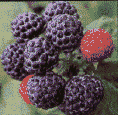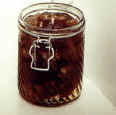Raspberries
Raspberry information, history and recipes
Â
Â
Â
Â
 Raspberries,
often referred to as brambles, are a member of the Rosaceae (Rose)
family, Subgenus Idaeobatus. There are over 200 species of raspberry, most
of which are red (European) and some of which are black (US). Botanically
speaking, raspberries not berries, but a collection of "drupelets",Â
each "drupe" containing a seed. They contain high concentrations of
Vitamin C and are an excellent source of folic acid, niacin, and riboflavin. Raspberries,
often referred to as brambles, are a member of the Rosaceae (Rose)
family, Subgenus Idaeobatus. There are over 200 species of raspberry, most
of which are red (European) and some of which are black (US). Botanically
speaking, raspberries not berries, but a collection of "drupelets",Â
each "drupe" containing a seed. They contain high concentrations of
Vitamin C and are an excellent source of folic acid, niacin, and riboflavin.Â
Â
Â
Origin
and History of Raspberries
Â
Whilst
red raspberries are thought to originate in Asia Minor, there are Roman records
dating back to the 4th century AD. It is natural to assume that the Romans
initially spread the cultivation of raspberries throughout Europe however it was
the English who cultivated, hybridised and improved them throughout
the middle ages and subsequently exported the plants to the US by the late
1700's.
Â
 The
Black raspberry is indigenous only to North America, where it is most abundant
in the east. Domestic cultivation seemed to have been delayed until the
1800s due to the popularity of red raspberries which were classed as a luxury up
until that time. The
Black raspberry is indigenous only to North America, where it is most abundant
in the east. Domestic cultivation seemed to have been delayed until the
1800s due to the popularity of red raspberries which were classed as a luxury up
until that time.
Â
Some
cultures consider the raspberry as a love-inducing fruit. More commonly
raspberry is used during pregnancy in tea or other vehicles for combating the
nausea and vomiting that accompany morning sickness.
Â
Â
Cultivation of Raspberries
Â
Raspberries
can be grown just about anywhere in temperate zones where the summers are not
too hot. The fruit are produced on "canes" which are usually
trained up trellis, fences or wires. They should be grown in full sunlight,
although a little shade can be tolerated, and they grow best in
well-drained, sandy loam soils which are rich in organic material. The
best time to plant raspberries is in the autumn, after fruiting.Â
Â
Whilst
the plant itself is a perennial, the canes should be cut back to ground
level once they have fruited, when new canes will start to shoot and can be
trained to take their place. The picking season is usually mid summer (Mid
June -Â July in the UK) although there are now varieties which extend the
season, both earlier and later.
Â
Buying and storing Raspberries
Â
When
buying, look for firm, dry berries. Avoid very soft fruit, or those with any
trace of mildew. They are highly
perishable and should be stored in the refrigerator as soon as possible after
purchasing or picking.
Â
 Freezing
Raspberries:Â Arrange in a rigid container in a single layer. Freezing
Raspberries:Â Arrange in a rigid container in a single layer.
Â
Preserving raspberries: As with all jams and preserves, only good quality fruit should be
used. Do not be tempted to use fruit which are past their best. There are a
couple of recipes listed below which should ensure you can make the most of any
glut.
Â
Tinned:
These are particularly suitable in the making of sauces and coulis.
Â
Â
Â
Click here for
lots of sweet & savoury raspberry Recipes
Â
Â
|